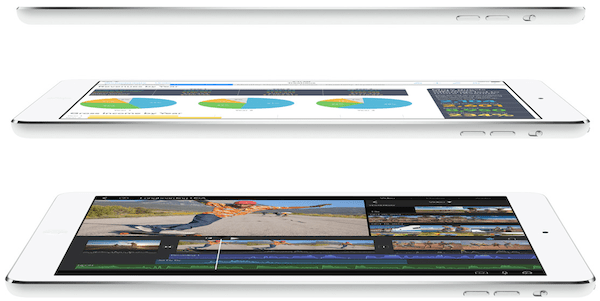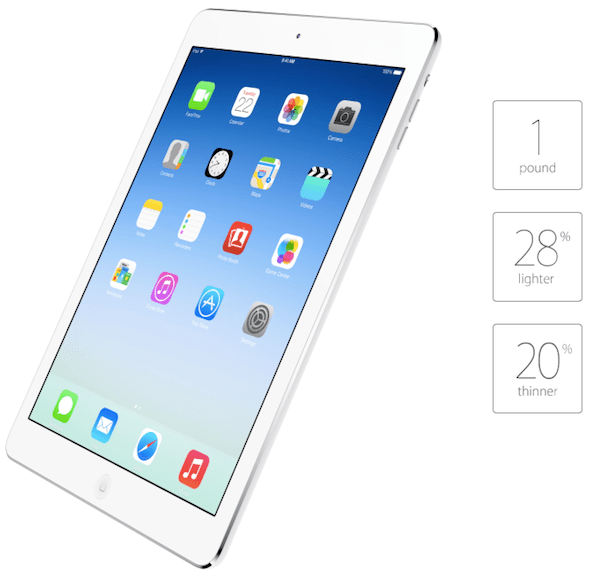
During the media event Tuesday, October 22, Apple unveiled its fall lineup, including a new operating system, OS X Mavericks, and hardware upgrades to the Mac Pro, MacBook Pro, iPad mini, and the completely redesigned iPad Air. Phil Schiller, senior vice president of worldwide marketing, commented the iPad overhaul was significant enough to warrant changing the name from would-be iPad 5, to the new “iPad Air.”
Taking design ideas from iPad mini, iPad Air is now a more curved form factor with rounded and chamfered edges. Edge to edge, the Air is only 6.6 inches wide thanks to the reduced side bezel, also lending credit to the mini. New mute switch and volume buttons match the mini as well. Most impressively, the iPad Air is now pencil thin, like the iPad mini retina, as both are 7.5mm thin. The thinner Air is made possible by a 24% overall reduction, while shedding weight, to produce a one pound device.
Between smaller and lighter, the Air will most likely prove to be a new challenge for consumers trying to pick between the smaller mini at $399 and the full size Air at $499. The Air is still producing major pixel density at 2048 x 1536 at 264 pixels per inch. With this Retina quality display, the human eye cannot discern individual pixelation at regular working distances.
All new A7 processor and M7 co-processor is the two-step process to eliminating constant battery drain. Apple first introduced the A7 processor a few months ago on the iPhone 5s. According to Apple, A7 is the most powerful processor to date for iPad and it is considered a desktop class chipset, allegedly operating at twice the speed of iPad 4, thanks to a 64 bit upgrade. As Apple designs its own processors, it can give certain functions to the chip and move computing elsewhere, hence the new M7 co-processor. Dividing the workload to the less power consuming M7 increases battery life on the new model.

M7 is specifically designed to track Air’s motion. Whether walking, riding, or driving, the M7 constantly tracks movement data through internal sensors like the accelerometer. With this information, data can react for the given situation and divert computing to the more power efficient co-processor. For example, if looking for directions through the mapping app while driving or moving at a high rate of speed; the app will default to providing driving instead of walking directions and change processors to the M7 for continued monitoring.
Other assorted internal enhancements include multi-band LTE coverage for more countries outside the US. Two WiFi antennas help to increase internet speeds as a multi input multi output radio is installed, which is AC compatible. Also, making FaceTime calls will be more pleasant with an HD front facing camera coupled with a dual microphone system to eliminate background noise. Stereo speakers make their way to the full size iPad for the first time along with the new Lightning port located between.
iPad Air is available through retailers as of Friday, November 2. Like the iPhone 5s, Apple did not offer a pre-order option, causing customers to order online during the morning hours and wait days for their units to arrive. The Air starts at $499 at 16GB WiFi only and $629 for a WiFi + cellular LTE model. More details are available through the Apple website.




